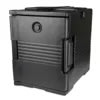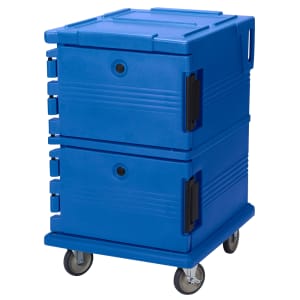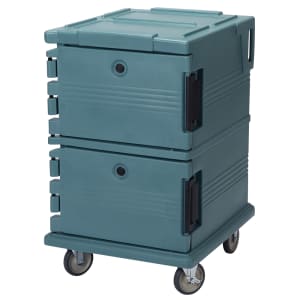Insulated Food Carriers
Insulated food carriers provide operators with a way to keep food hot between cooking and serving, which is essential in preventing potentially dangerous bacteria from growing. These carriers, which include food carrier bags, are a cost-effective way to ensure your food doesn't fall below safe temperature levels. More

Each end loader has a door on at least one side for loading by either stacking pans or resting them on slides.

These seal tightly to protect food quality and have removable or hinged tops for single or stacked pan loading.
Capacities for food carriers vary greatly, and KaTom offers a range of hot food carrier models that can carry between one and sixteen standard food pans, ensuring you'll find an appropriate insulated carrier for your purposes.
Common Questions About Insulated Food Carriers
How do insulated food carriers work?
Insulated food pan carriers work by preventing heat transfer between the inside of the container and its surroundings. This provides an environment in which hot food will remain hot – and cold food will remain cold – for long periods of time. Maintaining an appropriate food temperature is vital in ensuring customer safety, especially if you cannot serve your cooked meals right away. Of course, the right temperature is also important in serving a meal that tastes good, and that requires keeping hot food from overcooking. Our food pan carriers are built to maintain safe temperatures without reaching heats that would continue to cook food during transit or waiting.
What establishments need food carriers?
Catering is the most common type of endeavor that requires these insulated carriers. Providing food for events far from your kitchen requires significant safety considerations, in addition to achieving the right tastes and textures. Food that rests for too long in the danger zone for bacterial growth – that is, temperatures between 40 and 140 degrees Fahrenheit – becomes unsafe for human consumption. Caterers must find a way to keep their food out of the danger zone for the time period between cooking and serving the food. Catering hot boxes are made specifically for this purpose, although other establishments can make use of the insulated carriers as well. Anyone who needs to keep food hot while waiting or transporting it to its final destination will need something along the lines of these insulated food box containers.
Can I get a catering hot box that warms itself?
Some of our insulated containers do have warming options that provide extra heat to keep your food in safe temperature zones for extended periods of time. These options will require an external power source, such as a standard 120-volt outlet, to provide this heat, and the hot food carrier machines are not intended to actually cook any food. They will not bring your meals to a high enough heat to effectively cook or sterilize the food. The heating units will also insulate your food when they are not plugged in, but not for the same length of time. Consult the individual product specifications before purchasing a hot food carrier to determine whether or not it will meet your needs.
What's the difference between end- and top-loader carriers?
End-loader carriers have a door on one or more sides that facilitate loading restaurant pans, and top loaders, like most food carrier bags, open from the top of the device for loading pans from above. End loaders will typically have shelving on which your pans can rest, while top loaders require stacking food pans on top of each other during transport. Consider the shape and consistency of the food you'll be moving before choosing between top and end loaders.


